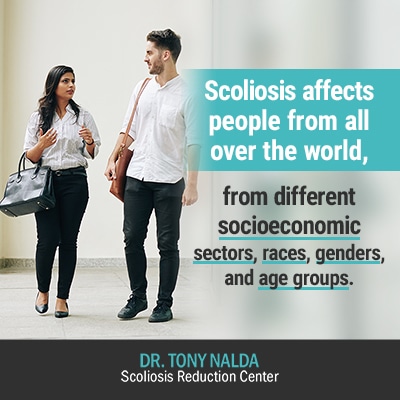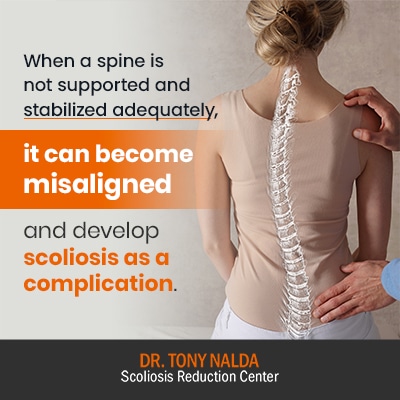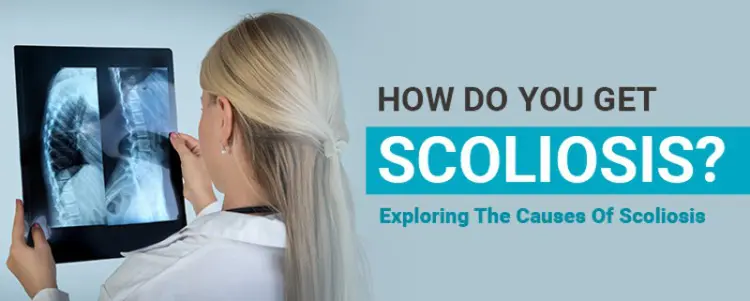One of the first questions people want answered when they receive a medical diagnosis is how and why they developed their condition. The problem with answering this question, in the context of scoliosis, is not only that the answer will vary depending on the type of scoliosis a person develops, but also because we don’t fully understand the etiology of the condition’s most common form.
Scoliosis is structural in nature. It’s not something that can be caught from someone else, and despite its prevalence, there are still many unanswered questions regarding its causation. Also, with multiple types of scoliosis, the answer will vary depending on the condition’s form: idiopathic, degenerative, congenital, neuromuscular, or traumatic.
Let’s start answering the question of ‘how do you get scoliosis’ by taking a look at its prevalence. Then we will move on to the different types of the condition a person can develop, and what we know about each form’s causation.
How Many People Have Scoliosis?
While most people know the defining feature of scoliosis, an abnormal sideways curvature of the spine, many don’t realize how widespread the condition is.
According to the National Scoliosis Foundation, current estimates put 6 to 9 million people living with scoliosis in the United States alone: 2 to 3 percent of the population.
When it comes to school-aged children, scoliosis is the most prevalent spinal condition.
Keep in mind, these numbers include ‘known’ cases and only those living in the United States. Imagine how those numbers would increase if we were somehow able to determine the number of people living with the condition unaware, plus include estimates of people living with the condition in other nations.

Scoliosis affects people from all over the world, from different socioeconomic sectors, races, genders, and age groups.
While scoliosis can be diagnosed at any age, the most common age of diagnosis is between 10 and 18, coinciding with the most crucial time for treatment as this age group is at risk of rapid-phase progression.
Now that you have an idea of just how widespread the progressive spinal condition is, let’s shift gears to looking at the many different types that can develop, and what we know about each form’s causation.
Idiopathic Scoliosis
As mentioned, the most common age of diagnosis is between the ages of 10 and 18, making up the adolescent idiopathic scoliosis (AIS) group. While we know how to respond to the condition with proactive and effective treatment, the causes of scoliosis are not as well understood.
The ‘idiopathic’ classification means it has no single known cause and is, instead, generally considered to be ‘multifactorial’: a combination of unique factors, that can vary from person to person, contributing to the condition’s development and progression.
Cases of AIS make up 80 percent of the known diagnosed scoliosis cases in the United States, with the remaining 20 percent consisting of forms of scoliosis with known causes.
It can be difficult to explain to someone recently diagnosed that their condition is idiopathic. It’s hard to not have the answers my patients want, and it’s also hard to see how the condition’s idiopathic nature can play into a patient’s feelings of powerlessness and loss of control.
At least, if the condition has a known cause, the person can understand their scoliosis better and why they have hit that bump on their journey; when there is no definitive understanding of how and why a person developed their scoliosis, that can make the person feel even less in control of their bodies and lives.
A comforting thought I provide in response is that although I might not fully understand the condition’s etiology, I most certainly know more than enough in order to manage and treat it effectively.
We know that this age group (between 10 and 18) is most commonly affected because we understand the main trigger for the condition’s progression: growth. Obviously, this age group that is entering into, or is in, the stage of puberty faces significant, rapid, and unpredictable growth spurts.
I like to point out that even if we were to fully understand the condition’s causation, that doesn’t necessarily mean it would change our course of treatment. I try to get my patients to focus on looking forward with as much positivity as possible: “I have this condition, now what am I going to do about it?”
Now, we have talked about the condition’s most common form affecting adolescents and what an ‘idiopathic’ designation means, but what about adults?
Scoliosis in Adults
As mentioned, scoliosis can develop at any age, and while it’s most commonly diagnosed in children and adolescents, adults can develop it too.
There are two main forms of scoliosis in adults: idiopathic and degenerative. One has no known cause, and the other does.
When idiopathic scoliosis presents in adults, we know that these cases are individuals who had AIS but were unaware of their condition until reaching adulthood.
While it can be hard to understand how a person with a spinal condition can go through their entire adolescence without knowing something is amiss in their body, it’s actually a lot more common than you might think.
A feature of AIS is that it isn’t painful; this is the case with individuals who have not yet reached skeletal maturity. Due to the constant lengthening motion a growing spine is experiencing, the compression caused by the abnormal spinal curvature is being counteracted.
In adults who have reached skeletal maturity, scoliosis can cause varying levels of pain. In fact, it’s mainly pain that brings adults in to see me and leads to a diagnosis of adult idiopathic scoliosis.
These cases are unfortunate because had these individuals learned of their condition earlier and started treatment sooner, they would be in far better shape than most are by the time I see them; their condition has been left to progress unimpeded for years into adulthood, when it started to produce noticeable symptoms such as pain, mobility restrictions, and postural changes.
While this form of adult scoliosis has no known cause as it’s idiopathic in nature, adults can also develop degenerative scoliosis, the second-most common form of scoliosis in adults, and this one has a known cause: degeneration.
Degenerative Scoliosis
Also known as ‘de novo’ scoliosis, degenerative scoliosis is most common in adults over the age of 40. ‘De novo scoliosis’ refers to cases of adult scoliosis with no prior history of the condition, unlike idiopathic scoliosis in adults.
This type of scoliosis affects older people because it’s partially caused by the natural degenerative effects of aging. As the body starts to show signs of general degeneration over the years, so too does its individual parts, such as the spine.
The development of degenerative scoliosis in adults occurs because there is an issue with the spine’s overall health and function. Commonly, it’s a person’s intervertebral discs that are affected by age-related degeneration, plus the cumulation of certain lifestyle choices: inactivity, not maintaining a healthy weight, not drinking enough water, and/or lifting objects incorrectly and straining the back repeatedly.
While a certain amount of degeneration is to be expected as we age, choices made over the years also factor in.
Degenerative scoliosis is commonly caused by the development of degenerative disc disease. As the intervertebral discs provide the spine with structure, flexibility, cushioning between the vertebrae, and act as the body’s shock absorbers, when their health is compromised, it makes it more difficult for the spine to maintain its healthy curvatures and alignment.
Once the discs are no longer able to perform their many duties optimally, the spine can become misaligned as it no longer has the structure and support it needs, causing the onset of degenerative scoliosis.
Let’s now move on to other forms of scoliosis with known causes: congenital, neuromuscular, and traumatic.
Congenital Scoliosis Causation
In cases of congenital scoliosis, the condition developed in utero as a result of a bone malformation in the spine.
To switch over to some basic spinal anatomy, the spine is made of bones called vertebrae. The vertebrae are stacked on top of one another, separated only by the intervertebral discs.
Picture the vertebrae as rectangular in shape, and what would happen if one of those bones were triangular in shape. Clearly, the spine would be unable to develop normally with its healthy and characteristic curvatures.
This form of scoliosis is quite rare, occurring in only 1 out of 10,000 newborns. It’s not uncommon for children with congenital scoliosis to have additional health problems such as bladder or kidney issues.
In addition, while congenital scoliosis is present at birth, sometimes, spinal problems aren’t detected until adolescence.
Neuromuscular Scoliosis Causation
As we have explored the most common form of scoliosis (AIS), let’s now take a look at the second most common form: neuromuscular scoliosis.
When a person develops neuromuscular scoliosis, the development of scoliosis is a secondary complication of a serious nerve or muscular condition, such as cerebral palsy, muscular dystrophy, or spina bifida.
These types of neuromuscular conditions involve a disconnect between the brain and the muscles and connective tissues that help support and stabilize the spine. They can affect the brain, spinal cord, and the muscular system; depending on the disorder and its severity level, one or more areas can be affected.
As the brain and spine work in tandem to facilitate communication and transfer signals throughout the body, when a condition adversely affects these systems, the nerves and muscles that surround the spine are impaired, making them less able to provide the spine and trunk with balance and stability.

When a spine is not supported and stabilized adequately, it can become misaligned and develop scoliosis as a complication.
Now, let’s take a closer look at the specifics of the main neuromuscular conditions associated with scoliosis development.
Cerebral Palsy
Cerebral palsy directly impacts the body’s musculoskeletal system and the ability to move and balance.
Commonly caused by damage experienced by the brain in utero, cerebral palsy can range greatly in severity and is commonly diagnosed around the age of 4.
When a person is living with cerebral palsy, their ability to balance the body and control the nerves and muscles located closely to the spine is compromised; this has the potential to cause the development of an abnormal spinal curvature.
Spina Bifida
Known as one of the most common birth defects, spina bifida also develops in utero. It involves the inability of the embryo’s neural tube to close; this is important because the neural tube later develops into the brain and spinal cord.
The result is a malformed spinal cord, including its coverings, and/or the bones of the spine (vertebrae). Malformed spines of this nature are vulnerable to misalignment and the development of scoliosis as their overall health and function are already compromised due to the underlying neuromuscular condition.
Muscular Dystrophy
There are multiple forms of muscular dystrophy (MD) that guide the occurrence of scoliosis within the disorder. In fact, muscular dystrophies make up a large group of approximately 30 genetic diseases characterized by the weakening and degeneration of skeletal muscles that are charged with controlling movement and balance.
Some muscular dystrophies are present at birth, while others appear in infancy or not until adolescence.
The weakening of skeletal muscles caused by muscular dystrophy leads to a weaker spine less capable of maintaining its healthy curvatures, as it no longer gets the support and stabilization it needs.
Traumatic Scoliosis Causation
Traumatic scoliosis development is caused by the presence of spinal tumors pressing on the spine, accidents, surgeries, or other body traumas that adversely affect the spine.
Now that we have touched on the main forms of scoliosis, plus the specifics of the unknown and known causes of each, let’s address a common and relevant question: is scoliosis hereditary?
Is Scoliosis Genetic?
The question of whether or not scoliosis is genetic has been at the center of ongoing debates over the years.
I can understand why there is a strong temptation to label idiopathic scoliosis as ‘genetic’, but despite its prevalence, and the years of studies and research on the subject, we have yet to isolate a single gene, or genetic mutation, responsible for its occurrence.
As no genetic link has been found, scoliosis is often, instead, described as ‘familial’. Now, this can sound like it means the same as ‘genetic’, after all, we are talking about conditions that run in families; however, what people often discount is the fact that families share a lot more than just their genes.
Families share the same socioeconomic and environmental factors, diets, lifestyles, responses to stress, and postural habits.
There are even cases of identical twins where one has scoliosis, while the other never develops the condition.
Returning to what was said earlier regarding the multifactorial nature of idiopathic scoliosis, one has to wonder if this aspect of its nature could be drawing on multiple shared variables within a family, rather than the family’s genetics, and it’s these shared factors that lead to the condition’s development.
Conclusion
Scoliosis has been around for hundreds of years, yet we still don’t fully understand the condition’s etiology.
While the vast majority of scoliosis cases, 80 percent, are idiopathic, the remaining 20 percent have known causes: degenerative, congenital, neuromuscular, and traumatic.
While I can’t discount the value of gaining a full understanding of the condition’s etiology, I can say that having this understanding wouldn’t necessarily change my treatment approach, or its efficacy.
The important thing is that while we don’t fully understand the guiding force behind the development of idiopathic scoliosis, we know what to do once it’s discovered: diagnose, classify, and treat it effectively.
With the type of proactive functional treatment we offer here at the Scoliosis Reduction Center®, regardless of a condition’s initial cause, in most cases, we can work towards improvement in the form of a curvature reduction achieved via scoliosis-specific chiropractic care, in-office therapy, custom-prescribed home exercises, and custom corrective bracing.
In cases of neuromuscular scoliosis where the scoliosis has developed out of impairments caused by a dominant neuromuscular disease, the underlying cause of the scoliosis (neuromuscular condition) has to be the guiding force of treatment, and these cases, unfortunately, don’t carry as much potential for positive treatment outcomes.
So to clearly answer the question, how do you get scoliosis, you can now see why the answer varies based on the type of scoliosis in question.





